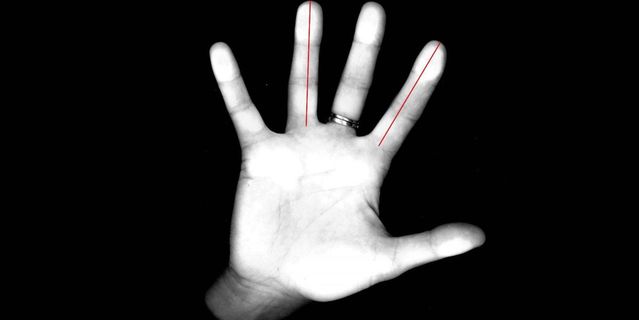Testosterone
The Neuroscience of Finger Length Ratio and Athletic Prowess
There may be a link between finger length ratios, testosterone, and athleticism.
Posted October 14, 2016 Reviewed by Jessica Schrader

People who have a shorter index finger in relation to their ring finger may have better spatial cognition and athletic prowess, according to a new study. The October 2016 report appears in the journal Behavioural Brain Research.
Researchers have known for some time that if someone’s index finger is shorter than his or her ring finger that this person was probably exposed to larger amounts of testosterone at a crucial stage of fetal development. Regardless of gender, levels of testosterone in the womb affect someone's finger length as an adult.
The digit ratio 2D:4D refers to the difference in length between the second digit (index) and fourth digit (ring) fingers. This ratio is calculated by dividing the length of the index finger of the right hand by the length of the ring finger. A longer ring finger and shorter index finger typically indicates a low 2D:4D ratio and greater in utero exposure to testosterone.
For people of all genders, the length of your various fingers is linked to the complex balance and interplay of hormones you experienced in the womb. Boys, girls, and people of intersex are exposed to various amounts of testosterone in the womb. Each of us was exposed to slightly different combinations of male and female sex hormones, such as testosterone and estrogen, before we were born.
Generalizations Based on 2D:4D Offer Clues But Are Not Definitive
Making broad sweeping, deterministic generalizations about inherent personality traits or athletic potential based solely on the length of someone’s fingers would be ludicrous and reckless. Anytime a scientist identifies a physical trait that might increase the occurrence of a desirable (or undesirable) characteristic, it’s imperative that we proceed with extreme caution.
The correlation between digit ratio and athletic ability could easily be misconstrued in a way that inadvertently promotes eugenics. Obviously, there are so many complex factors that occur in early life that shape who each individual human being becomes in adulthood. Scientists are just beginning to understand the interplay between genetics, epigenetics, nature, nurture, environment, etc.
That said, the new study on spatial cognition and digit ratio by Carl Pintzka—a neuroscientist at the Norwegian University of Science and Technology (NTNU)—adds to a growing body of research that has unearthed various characteristics that are linked to finger length ratios.
As an example, the amount of testosterone in the womb has been associated with an increased risk of developing diseases in adulthood that are more common in men, such as autism and Tourette's syndrome. Conversely, low levels of in utero testosterone are associated with an increased risk of developing disorders that are typically more common in women, such as anxiety and depression.
Risk of Motor Neuron Disease May Be Linked to Prenatal Testosterone Levels
One of the most interesting neuroscientific aspects of digit ratio research is the discovery that fetal hormonal balance may be associated with someone’s odds of developing various neurological diseases. For example, a 2011 study from King’s College London found that finger length ratio offered clues for predicting someone's risk of motor neuron disease (MND) in adulthood. These findings were published in the Journal of Neurology, Neurosurgery and Psychiatry.
People with the most common form of MND—amyotrophic lateral sclerosis (ALS) also known as Lou Gehrig's disease—are more likely to have relatively long ring fingers. In both women and men, motor neurons depend on testosterone for survival. Interestingly, men are more likely than women to develop MND and are generally exposed to higher levels of testosterone before birth.
Researchers from the Institute of Psychiatry at King’s College, led by Ammar Al-Chalabi, suspected that the link between MND and gender might be the result of high prenatal testosterone levels rather than simply being of the male sex. They hypothesized that the risk factor of developing MND in later life might be correlated with the adult motor neurons being less responsive to testosterone. In a Statement to King's College, Al-Chalabi said,
"This work suggests that even before birth, motor neurons can be affected in ways that make them more vulnerable in later life ... so what we see as a trend towards longer ring fingers is just a marker for the hormone balance during pregnancy. The same trend is seen in sporty people and men, which is why this can never show someone will get motor neuron disease, it is just a clue as to what might be making motor neurons more fragile."
Dr. Pintzka’s research corroborates Al-Chalabi’s observation that a greater level of prenatal testosterone—as represented by a ring finger being longer than the index finger—suggests that someone is more likely to excel in sports. In a statement to NTNU, Pintzka said, "The greatest effect has been found for various physical and athletic measures, where high levels of prenatal testosterone are consistently linked with better capabilities.”
Longer Ring Finger and Shorter Index Finger Ratio Linked to Athletic Prowess

According to Pintzka’s recent findings, both women and men with a low 2D:4D ratio are—on average—better equipped to solve mentally demanding 3-D rotation tasks. As a group, they also tend to have better athletic abilities. On the flip side, low levels of testosterone and a higher 2D:4D are associated with better abilities in verbal memory tasks, such as remembering a list of words. Again, these generalizations are not universal or set in stone.
The recent NTNU findings stem from Pritzka’s doctoral dissertation in which he examined previous theories of finger length, spatial cognition, and brain differences between men and women. His most recent study focused on how testosterone affected different spatial abilities in women. After being given an oral dose of exogenous testosterone, the female study participants were asked to navigate a virtual maze and to mentally rotate different three-dimensional objects.
According to Pintzka, his study results indicate a trend towards a positive effect of high testosterone levels on spatial abilities. However, he emphasizes that a larger study would be necessary to show a significant correlation and that it's too early to draw definitive conclusions based on his findings.
Nonetheless, there does appear to be some type of link between digit ratios and certain brain functions that are highly sensitive to testosterone throughout our lifespan. Future research will help to answer unresolved questions about the correlation and causation of higher levels of in-utero testosterone exposure and 2D:4D ratios.




